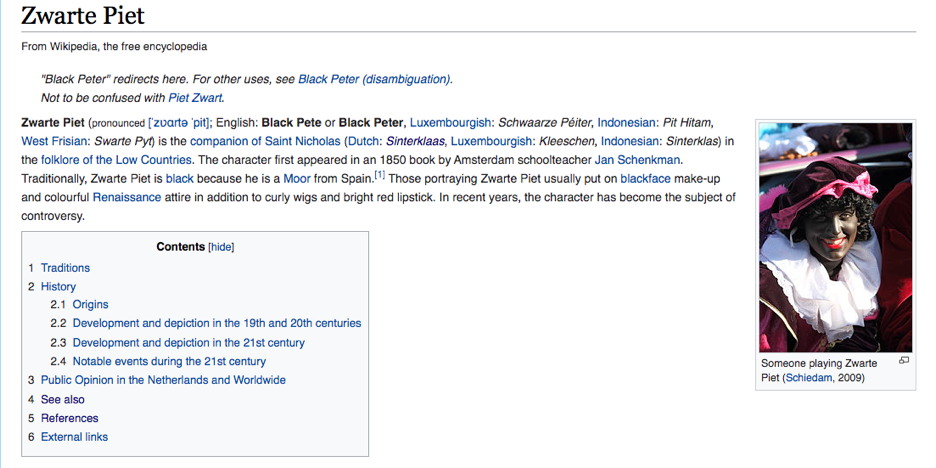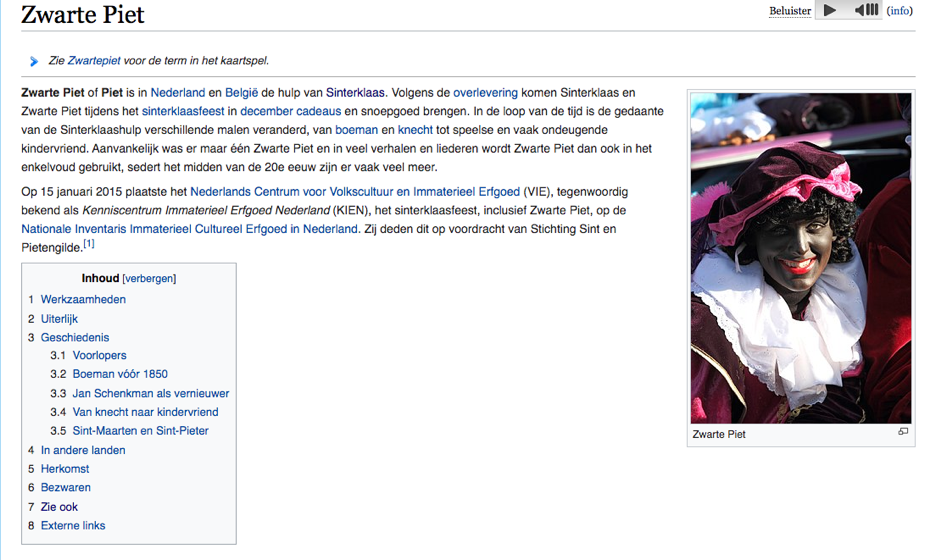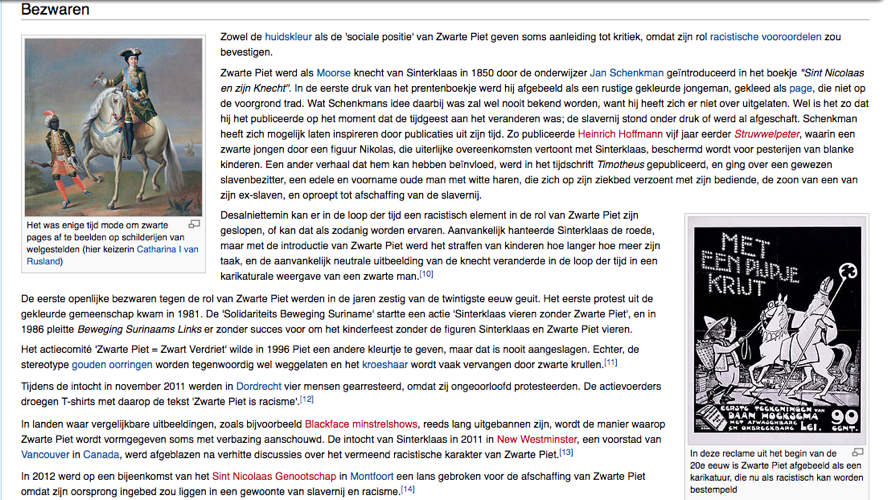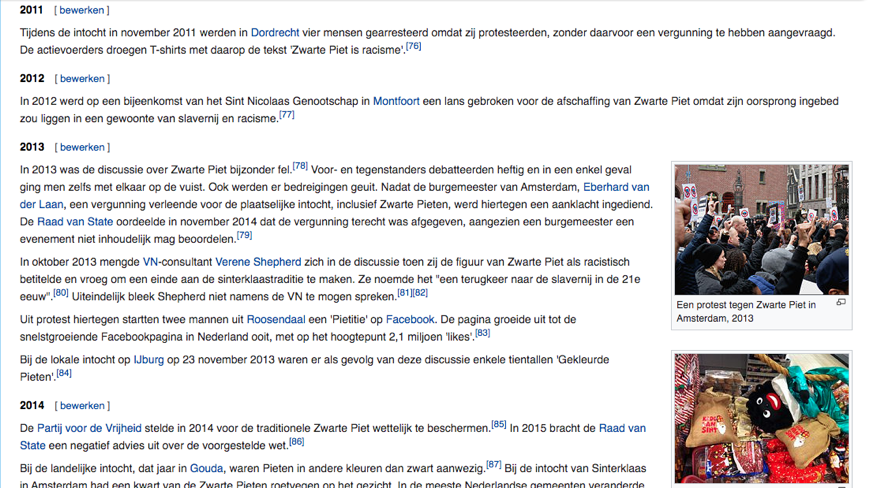Mapping the evolution of public opinion on the Zwarte Piet debate as reflected on the Dutch & English language versions of the Zwarte Piet Wikipedia page
The accessibility to information on the internet has rendered it a formidable means for knowledge acquisition. Moreover, the proliferation of user-generated content has enabled knowledge production to be collaborative and participatory (Niederer & van Dijck). A popular artefact in this collaborative knowledge is Wikipedia (Tcakz). Information on Wikipedia is constantly [re]negotiated and therefore never complete. This is given the platform’s device-culture, which involves continuous processes of content creation and editing by [other] Wikipedians (Welteverde & Borra). Wikipedia lacks a central source of authority, and so each Wikipedian has as much right as the other in editing information – given that there is a reliable, external source to verify said edit. Consequently, one of Wikipedia’s most defining affordances is the creation of unstable encyclopaedic knowledge (Welterverde & Borra, Wales). This instability and incompleteness is often observed in articles through the constant edits made by [other] Wikipedians, who can [and often do] hold opposing or unaligned views on a given topic.
Wikipedia’s purpose is to act as an encyclopaedia to its readers: an exhaustive platform with information on any and every branch of knowledge (Welterverde & Borra). It therefore strives to maintain a neutral point of view policy, wherein debates may be described and explained, but not engaged in by Wikipedians (Massa & Scrinzi). However, maintaining such neutrality is much easier in theory than in practice. For one, objectivity is a highly nuanced concept – even more so across cultures. As Westerman asserts, “all knowledge is produced within the communication conventions of a particular community, and disseminated in ways that are acceptable to a degree held customary to that same community” (p.123). Cultural nuance plays a significant role in knowledge production, and thus knowledge consumption is highly susceptible to cultural preconceptions and prejudices. Wikipedia, being deemed a cultural reference for knowledge, then, has a high potential for discrepancies based on diverse cultural understandings, particularly regarding topics that are highly debated across communities. Examining cultural differences on controversial topics on Wikipedia would reveal much about the different cultural perceptions of these issues, given Wikipedia’s dominance as one of the most accessed online resources for knowledge acquisition (Massa & Scrinzi). Moreover, Wikipedia’s range of different language versions of the same article allows for the examination of discrepancies across global communities.
Our research aims to examine and compare the evolution of local and global opinion on Zwarte Piet, the longstanding Dutch folkloric character who is the companion of Saint Nicholas. Historically known as a Moor from Spain, Zwarte Pietis traditionally recognizable by his dark skin, which is often achieved through blackface. We chose this topic because of its relevance not only in the Dutch community, but also in many global POC communities. Moreover, we were highly interested in the controversy surrounding the topic, given the diversity in opinions concerned with it. While there is a growing opposition towards Zwarte Piet’s discriminatory depiction, there is also vigour in the voices that claim Zwarte Piet’s appearance must be maintained to uphold Dutch tradition. We therefore feel that our research, as well as the debates surrounding Zwarte Pietin general, are unquestionably significant to ethnic communities that make up the Dutch-speaking demographic. Therefore, we formulated the following research question:
How have the local and global opinions of Zwarte Piet evolved over time, as reflected on the Dutch & English language versions of the Zwarte PietWikipedia page?
With this research question, we aim to examine the two pages, with the purpose of exposing potential differences that may reflect the differences in perception across the Dutch-speaking [local] community and the English-speaking [global] community. We also aim to examine the evolution of the debate on both language versions of the Zwarte PietWikipedia page, in order to reveal the introduction and evolution of the controversy into the public conscience.
Methodology
Wikipedia is an open-collaboration project: anyone and everyone who wishes to edit the existing information on a given article is allowed to do so. As Jimmy Wales, co-founder of Wikipedia asserted, “one person writes something, somebody improves it a little, and it keeps getting better, over time”. This particular characteristic of Wikipedia, where articles are subjected to repeated scrutiny (Rogers) makes it an encyclopaedia that is constantly evolving and adapting to new developments, thus staying ever-relevant. This dynamic nature of Wikipedia comes in handy for our research that aims to assess how the controversy around Zwarte Piet has evolved over time, as reflected on its Wikipedia language versions.
In order to effectively pursue the research question, we took a digital-history approach to the selected Wikipedia articles using the Wayback Machine. Much like Wikipedia, which is considered to be an online encyclopaedia, the Wayback Machine, launched in 2001, can be referred to as an online library of the World Wide Web that preserves digital archives and other useful information on the Internet to bolster journalistic and scholarly research pursuits. With the aim to examine how the English and Dutch language Wikipedia versions of Zwarte Piet have evolved over time, we collected and examined the screen-captures of the articles right from the year of creation to present-year using the Wayback machine.
The reason for choosing the Dutch article (Zwarte Piet) and English article (referred to as ‘Black Pete’ henceforth) is that the celebration of Zwarte Piet [and Sinterklaas] is a practice prominently prevalent in the Netherlands. With a brief research on the edit history and the editors involved in Zwarte Piet’s Dutch article, we learnt that almost every editor belonged to or is based in the Netherlands. This was realised using the tool ‘Wikipedia Edits Scraper and IP localizer’ developed by the research group Digital Methods Initiative. The tool helped us in scraping the queried Wikipedia article’s history and converting IP to Geo for anonymous edits, subsequently revealing the location from where the edits were made. The same task was also carried out with the English language version of the Wikipedia article and it was known that a great number of editors were based outside the Netherlands, despite the tradition not being native to their respective regions. Canada, United Kingdom and the United States were among the prominent regions where the editors of the English language article were located. While editors from the Netherlands too were part of the English language article, their presence was not as dominant as observed in the Dutch article. Through this process, we leveraged the Dutch Wikipedia article on Zwarte Piet to be illustrative of the local opinions surrounding the topic, and the English article to be a global illustration of the same. Here, the word ‘illustration’ is used to assert the fact that the screen-captures by Wayback machine are mere visualizations that reflect previous debates on the topic, which help us in interpreting how the controversy has evolved.
We began our research by comparing the Dutch and English language versions of Zwarte Piet to flesh out the similarities and distinctions in both the articles. Here, we are solely concerned with the front-end of Wikipedia that a general user/surfer normally interacts with. It is important to assess the front-end because of two main reasons: the first being the dominance of Google in the search engine market share and second being Wikipedia’s relationship with Google. Wikipedia ranks highly in Google’s search results (perhaps better than any other website) for informational queries as a number of industry studies have found (Rogers). Hence, it becomes more than necessary to know what opinion/discussions around ‘Zwarte Piet’ is the majority internet audience subjected to? While we’ve established that the Dutch and English versions of the page respectively present the local and global opinions on the topic, it is also important to know if and how the general public is influenced by these opinions. Hence, a comparison between the two language versions acts helpful. After looking at markers such as sub-sections, titles, lexis of content, images etc., it was known that the ‘controversy’ section (titled ‘Bezwaren’ in Dutch [meaning ‘Objections’] and ‘Public Opinion’ in English) were among the most disputed ones, this was learnt by a brief look at the back-end section of the articles.
Considering the long-standing public debate and the edits-dispute over the ‘controversy’ sections, we further pursued the research to know how the controversy around Zwarte Piet has played out on the front-ends of local and global Wikipedia pages through the past years. In the process, a few interesting changes have been observed on the English and Dutch language version Wikipedia pages of Zwarte Piet, which are mentioned in the forthcoming section.
At the outset, it is also crucial to acknowledge the limitations of the study. As mentioned earlier, the Dutch language article of Zwarte Piet is held illustrative of the ‘local’ opinions on the topic, the reason being the majority of its editors belonging to the Netherlands (ground-zero). However, it is to be noted that a good share of editors working on the Dutch article were also located outside of the Netherlands and vice-versa with the assumptions made with regard to the English language version of Zwarte Piet. Another major limitation is: the ‘controversy’ section on the English page appeared only in 2019, which made us stick only to the Dutch page to study how the controversy have evolved.
Findings
Part 1
Comparing the English Wikipedia page (see figure 1) for ‘Zwarte Piet’ to the Dutch Wikipedia page (see figure 2), several significant differences between the pages become apparent. At first glance, the Dutch page is significantly longer than the English page, and contains more subheadings. While the Dutch page counts six main subheadings - work activities, appearance, history, in other countries, origin, and objections - the English page contains three subheadings - traditions, history, and public opinion in the Netherlands and worldwide. The Dutch page thus seems slightly more detailed, for instance describing and justifying the appearance of Black Pete.

Figure 1 Screenshot of the English Wikipedia page on black pete
(https://en.wikipedia.org/wiki/Zwarte_Piet#See_also)

Figure 2 Screenshot of the Dutch Wikipedia page on black pete
(https://nl.wikipedia.org/wiki/Zwarte_Piet#Zie_ook)
The introduction on the Dutch page explains who Black Pete is and how his character became part of the Dutch cultural heritage. The introduction on the English page also explains who Black Pete is, and taps into his appearance as a cause of controversy. While the Dutch page has a more positive and proud undertone in the introduction, the English page is relatively critical. Besides the introduction, both the Dutch and English page have a subheading for history.However, what is discussed in this section does differ on each page. On the Dutch page, this subheading starts with explaining the ‘forerunners’ of Black Pete from before 1850. It then goes into how Black Pete used to be depicted as evil. Furthermore, it discusses the ‘renewal’ of the celebration of Sinterklaas [Saint Nicholas], and how school teacher Jan Schenkman has influenced the way we nowadays celebrate this holiday in the Netherlands. Lastly, it explains the transition of Black Pete as an ‘evil’ character to ‘a friend of the children’. In general, the history subheading on the Dutch Wikipedia page seems to be a very extensive description of the development of Black Pete and the celebration of Sinterklaas. Comparing this to the history subheading on the English Wikipedia page, it becomes apparent that the Dutch page does not refer to the controversies that have arisen in the last few years surrounding Black Pete, while the English page does. Looking at the English subheading for historyin a bit more detail, we can see that the first half focuses on the origin and development and depiction in the 19th and 20th centuries. The second half of the subheading focuses on development and depiction in the 21st century and notable events during the 21st century, emphasizing the controversies and associated demonstrations surrounding Black Pete’s appearance.
The subheading objections on the Dutch Wikipedia page and the subheading public opinion in the Netherlands and Worldwide, are significant parts of texts to compare as they both illustrate the discussion surrounding the controversies on Black Pete. What stands out here, is that both pages do so in different ways. While the English page straightforwardly points to the idea that Black Pete became increasingly controversial in the late 20th century, the Dutch page solely points to connotations of racism. The Dutch page seems to not directly describe black pete as racism, rather the page argues that some elements of Black Pete sometimes can be experienced as discriminatory. The text argues that some people see Black Pete as a slave, after which an argument against this statement is being presented; slavery is a prevalent part of Surinamese history, but was unusual in the Netherlands, and old images showed Black Pete wearing shoes, which pleads for a status of a ‘free man’. Thus, on the one hand the English page focuses on illustrating how and why people from different ethnic backgrounds perceive Black Pete as disturbing and discriminatory. On the other hand, the Dutch page seems to almost prove the critiques against Black Pete wrong. Comparing the very last paragraph of both the Dutch and English page demonstrates this point very well.
Dutch Wikipedia page on Black Pete:
“The protests against black pete have also evoked counter-action. Advocates for black pete state that they are defending a Dutch tradition that - in their eyes - has nothing to do with racism”
English Wikipedia page on Black Pete:
“The public debate surrounding the figure can be described as polarized, with some protesters considering the figure to be an insult to their ancestry and supporters considering the character to be an inseparable part of their cultural heritage.”
After comparing both the Dutch and English Wikipedia Page regarding black pete, we also looked at how these pages changed over the years, by using the Wayback Machine as described in our methodology. This resulted in some interesting insights regarding the Dutch Wikipedia page. Yet, the results proved insignificant regarding English page, as the subsection about controversies on the topic of black pete first appeared in 2019. The fact that this issue has only gained coverage this year, is however in itself an interesting finding.
Part 2
Since the results from the Wayback machine for the English page did not provide us with sufficient insightful data, we decided to focus on the Dutch page and how the information about the controversies around black pete changed over time. The first time ‘controversy’ around Black Pete got its own subsection on the page was in December 2004. This subsection was titled ‘controversial’ and it briefly discussed the racist undertones of Black Pete (see figure 3). This subsection remained the same until 2005. In 2006, minor adaptations were made in the subsection. For instance, while before the section it was mentioned that most people think of Black Pete as a ‘children’s friend’, in 2006 the word most was replaced with some. When looking at the page in 2009, it becomes clear that the ‘controversial’ subheading was still there; however, it shrunk in size. Some sentences were deleted, and some wording was changed. In 2011, the subsection ‘controversial’ became significantly larger in size, examining both why some people perceive Black Pete as a reaffirmation of stereotypical prejudices, as well as why others think of the tradition as innocent (figure 4). It is also the first time the page talks about changes in the appearance of Black Pete, for instance the fact that golden hoop earrings were not always worn by the Black Petes anymore.

Figure 3 Screenshot of ‘controversial’ subsection on the Dutch black pete Wikipedia page in 2004
(https://web.archive.org/web/20041208064130/https://nl.wikipedia.org/wiki/Zwarte_Piet)

Figure 4 Screenshot of ‘controversial’ subsection on the Dutch black pete Wikipedia page in 2011
(https://web.archive.org/web/20111119101713/https://nl.wikipedia.org/wiki/Zwarte_Piet)
In 2013, the title of the subsection changed from ‘controversial’ to ‘objections’, signifying a change in the description of the debates surrounding Black Pete. It was also the first year that the page showed an image related to the controversy, as demonstrated in Figure 5.Even though this image was also used on the page in 2011, no description was given this year. However in 2013, the same image got a description saying: in this commercial from the beginning of the 20th century, black pete is portrayed as a caricature, which now can be labeled as racist. The section also discussed how there was a gathering in 2012 to call for abolishment of Black Pete as its origins are embedded in slavery and racism. Furthermore it discussed that the United Nations did research into the case of Black Pete because of its racist undertones, causing a lot of negative reactions from Dutch social media users. In 2015, the subsection for discussing the controversy was still named ‘objections’, and the section grew even larger in size. What’s significant here is that the subsection itself got 5 new subsections: objections in the Netherlands, discussion 2011-2014, Flanders, Curaçao,and other countries. For the first time, an image of a protest was used on the page. In 2017 the information about the controversies became even more detailed. While the subsections generally stayed the same, the subsection discussion 2011-2014 got replaced by discussion. This subsection presented a timeline from 2011 to 2016, discussing the most important developments that happened each year regarding controversies around Black Pete. In 2019, all these subsection under ‘objections’ disappeared and the section on controversies as a whole decreased significantly in length. This is the page in its current state, discussing the controversies around Black Pete in a rather general manner compared to previous years.

Figure 5 Screenshot of the Dutch black pete Wikipedia page in 2013
(https://web.archive.org/web/20131023210054/https://nl.wikipedia.org/wiki/Zwarte_Piet)

Figure 6 Screenshot of the Dutch black pete Wikipedia page in 2017
(https://web.archive.org/web/20170103182658/http://nl.wikipedia.org/wiki/Zwarte_Piet)
Discussion
According to the findings, there are significant differences between the Dutch and English Wikipedia pages. Generally, both of them included discussions around Zwarte Piet’s controversial appearance. However, each article depicted the discussion from varied perspectives. As for the Dutch page, although the contents admit the existing query about racism around this character, it tends to justify this tradition by providing a longer introduction about the history and revolution of Zwarte Piet, in order to avoid “strong simplification” that reduces Zwarte Piet to an expression of colonial thinking. The Dutch Wikipedia page indicates that in Dutch history, Zwarte Piet was rarely referred to as “slave” and that his character is rarely associated with racism or discrimination by the majority of Dutch people. However, from a global perspective, the current English Wikipedia page shows a polarized public opinion about Zwarte Piet that range across different ethnic backgrounds, age groups and regions. While most Dutch people hold a tolerant and respectful attitude towards their tradition (reflected in Dutch Wikipedia page), it not only receives a large amount of criticism from the local black community, but also from voices outside the Netherlands, which intensified the conflict between the willingness to retain the tradition and removing the character from St. Nicolas Festival. Apparently, there are biases embedded within two Wikipedia pages. In addition, no matter the bigger objection subtitle in Dutch page or the recent post of global opinion section in English page, it witnessed an increasing public concern round Zwarte Piet debates. Thus, it is necessary to discuss the potential reasons behind the differences in this paper.
The start of the Zwarte Piet debate can be traced back to the 1960’s, when, after half a century of intermittent, it witnessed an explosion of emotions and debates (Hilhorst and Hermes 220). Since then, the increasing accessibility of information and the flourish of social media has gradually pushed this debate even further into the public conscience. As mentioned in the findings, the Dutch Wikipedia page changed its subtitle from “controversial” to “objections” in 2013, revealing the arising counter voice against Black Pete. During this year, Verene Shepherd from United Nation publicly claimed that Black Pete was a racist figure, while a preservation movement of this tradition was launched on Facebook by two young Dutch men at the same time (Lemmens 125). Two million Dutch people signed to support this movement online. From then, social media has become a battlefield and a source of public opinion toward Black Pete, which helps us to figure out the reason behind Wikipedia differences. The Facebook research of Hilhorst and Hermes gives us some insights on why the Dutch tend to defend their tradition: 1) St. Nicolas is a festival celebrated for children. Children are innocent with regards to racism and there is no need to misguide the interpretation of Black Pete. 2) Zwarte Piet is part of Dutch tradition, and if it is changed or abolished, the other parts of the culture will be taken away as well, just like Zwarte Piet. 3) Immigrants and, more generally, people of color are treated well in the Netherlands, so they should be satisfied with the reality rather than offended by traditional culture. The opinions above reveal the reason why Dutch Wikipedia page tends to defend their culture.
It is true that Zwarte Piet is an inseparable component of Dutch culture. However, according to Solomos and Black, racism can be coded as culture. It could be problematic when people cannot be aware of the existence of potential stereotype or discrimination in their life. Therefore, along with the globalization process, when the city is embracing people from all over the world, the local custom should respect different cultural backgrounds as well. In 2013, 90% of Dutch did not perceive Black Pete as a racist character. This number reduced to 80% in 2018, while over 50% of people are willing to make changes (Wikipedia). The evolution of the Dutch Wikipedia page indicates a trend that more people, especially young groups, are willing to adjust the appearance of Zwarte Pieten.
Conclusion
Our research focused on the comparison of local and global perspectives surrounding Zwarte Piet, and how these perspectives have evolved over time. We aimed to examine this through an exploration of the Dutch and English language versions of the Wikipedia page on Zwarte Piet. Our study was therefore grounded in the assumption that Wikipedia is a cultural reference of knowledge. The differences observed in both the pages provide interesting insight into the way in which Wikipedia may shape and also reflect cultural perception, as well as reveal the evolution of certain perceptions over time, given the platform’s collaborative and editable affordances.
-
PS: This article is a result of collaboration between me and 3 other peers of mine from the University of Amsterdam.

0 Comments Add a Comment?